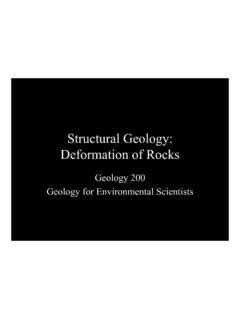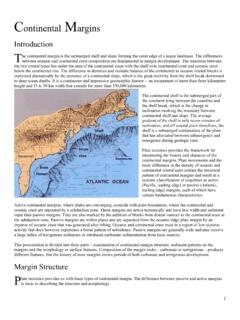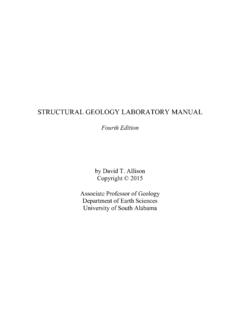Transcription of Some Geology Basics - Modesto Junior College
1 1 Some Geology Basics Geology (geo: earth , logos: knowledge or study of ) is the study of planet Earth. Geology is in many ways the most complex of sciences, as a complete understanding of the workings of the earth requires training in mathematics, chemistry, physics, biology, and astronomy. The study of the Earth brings mathematics, chemistry and physics alive. It provides the opportunity to test many hypothetical and theoretical principles in the real world as we observe chemical reactions in rocks, minerals, water and atmosphere, and physical reactions in earthquakes, landslides and volcanic eruptions. The Earth is a product (a by-product, really) of star formation, and thus requires an understanding of the workings of the cosmos. And all life on evolved on and is intimately related to planet Earth, and our continued existence requires a complete understanding of how the earth works, and how we can continue to utilize the resources on the planet without destroying the ecosystem that we are part of.
2 The science of Geology is generally divided into three subdisciplines: physical (the study of Earth materials and processes), historical (the study of the origin and development of the Earth), and environmental (the interrelationship of humans and the Earth). Our journey through the Colorado Plateau will most certainly touch on all of these areas. What follows is a brief introduction to this fascinating science. What the Earth is made of The solid Earth is composed of rocks and minerals. These two words are often lumped together, but they mean different things. Minerals are naturally occurring crystalline compounds that can be defined by a specific chemical composition. In practice, the most common minerals are identified by looking at specific physical properties unique to each: the luster (the way the mineral reflects light), the hardness, the presence or absence of cleavage (the tendency to break into flat planes), and many others.
3 Rocks are solid aggregates or mixtures of one or more minerals. In other words, a mineral is a single compound, and analysis of any part will give the same composition. A rock consists of numerous mineral grains in a solid mass, and thus will provide different compositions as each different part is tested. Rocks are identified as igneous, sedimentary, or metamorphic, based on their origin. 2 The Rock Forming Minerals There are thousands of different kinds of minerals, but over 95% of the earth's crust is igneous rock, and the igneous rocks usually contain no more than a few minerals and most of these are part of just four groups or families: these are called the igneous rock-forming minerals. The light-colored minerals are silica-rich and less dense. They are called the felsic minerals. The darker mafic minerals contain iron and magnesium, are denser, and only melt at high temperatures. The rock forming minerals are readily identified by observing certain basic physical properties.
4 Feldspar: The most common mineral family, the feldspars come in a variety of colors, including pink, white or gray. The most distinctive property is the tendency of the mineral to split or cleave in two directions. One variety, plagioclase feldspar may exhibit very fine lines, called striations, on some surfaces. These look like record grooves. The pink variety of feldspar is called orthoclase or potassium feldspar. All the feldspars can scratch glass. Chemically, the feldspars are aluminum silicates with varying amounts of calcium, sodium and potassium. Quartz: Quartz is easily distinguished by great hardness (scratches glass), clear or light color (many shades are possible: milky, pinkish, purple, smoky, etc.), and unlike the feldspars, it does not have cleavage. Instead it fractures into smooth rounded surfaces much like glass does (conchoidal fracture). When crystals are present, they have a distinctive hexagonal shape.
5 Quartz is a simple silicate composed only of silicon and oxygen. Mica: A mineral familiar to most people, mica's most distinctive property is the tendency to cleave into very thin sheets. The dark variety is known as biotite, while the lighter clear variety is muscovite. The micas are softer than glass. Both micas are complex silicates with varying amounts of aluminum, potassium and iron. Ferromagnesian Minerals: These minerals contain iron and magnesium in their chemical structure and are characterized by relative hardness, dark color (except for the bright green of olivine), and greater density. Amphibole (hornblende) is black and has a poorly developed cleavage. Pyroxene (augite) is usually greenish-black, also with cleavage. Olivine has no cleavage, occurs in granular masses, and has a bright apple-green glassy appearance. It is a main constituent of the Earth s mantle, the very thick layer underlying the thin continental or oceanic crust.
6 It is also known to many as the gemstone peridot. 3 Sedimentary Rock Forming Minerals Sedimentary rocks make up only a small percentage of the crust, but sediments and sedimentary rocks cover most of the planet s surfaces and sea floor. Sedimentary rocks may contain some of the igneous rock-forming minerals (especially quartz), but the process of weathering tends to break the minerals down into new forms. Clay: Around 70% of all sediments are composed of the clay minerals. The clays are the product of the weathering of feldspars and other igneous rock-forming minerals. They are generally characterized by an even fracture, an earthy (or dull) luster, and a distinctive odor (like moist soil) when wet. The clays are used in ceramics and building materials (adobe and bricks, for instance). Bentonite clay is a form that often develops from the weathering of volcanic ash, and is exposed widely in several formations on the Colorado Plateau, where it presents engineering problems because of the tendency of the clay to absorb water and swell.
7 Quartz is a very stable mineral at the earth's surface, but it will be much changed by sedimentary processes. Although it is often seen as small glassy grains of sand, in other cases, it occurs in a microcrystalline form called chert or agate. Microcrystalline quartz is found in many colors and forms, but can be distinguished by its extreme hardness (the only common sedimentary mineral that is harder than glass). Chert was often used by Native Americans to construct arrowheads and spear points. Calcite and dolomite are both carbonate minerals. Calcite is often the cement that binds sedimentary rocks together and at times makes up the entire rock (limestone). The most interesting property of calcite is the reaction of calcite when hydrochloric acid is dropped on it. It fizzes in a reaction called effervescence. Dolomite is similar to calcite in many ways but is less reactive to acid and is slightly harder.
8 The carbonate minerals often develop in warm shallow seas by both organic processes and by chemical precipitation. Dolomite is often secondary, developing when the already formed limestone reacts with magnesium rich groundwater. Halite and gypsum are called evaporite minerals, because they precipitate as water evaporates in coastal bays or desert dry lakes. Halite is none other than common table salt, and has cubic cleavage. Gypsum has platy cleavage, and is softer than a fingernail. It is used in a variety of ways, most commonly as drywall and plaster of Paris. Hematite (reddish brown) and Limonite (yellowish brown) are oxides of iron (in the most basic sense they are forms of rust). A small amount of either mineral is sufficient to stain other rocks bright red, brown or yellow. Many of the spectacularly colorful exposures of sedimentary rock in Grand Canyon, Zion and Bryce Canyon result from the presence of these iron oxide minerals.
9 4 The Rock Cycle Essentially all rocks are made of the remains of some kind of pre-existing rock. Igneous rocks develop because some previous rock melted. Sedimentary rocks form because previously exposed rocks were weathered. Metamorphic rocks result when previous rocks are changed by heat and pressure. If they get hot enough, they melt and form magma. This recognition that the crust of the Earth is a vast recycling system was one of the fundamental discoveries that made Geology a science two hundred years ago (figure 2). Figure 2: The rock cycle. Source: Geological Survey One consequence of the rock cycle model is the recognition that truly ancient rocks are very rare. Once exposed the rocks are eroded and become incorporated into younger rocks. As a result, no rocks on the billion year old Earth are older than 4 billion years, and in the western United States, the very oldest rocks date back to only billion years.
10 The oldest rocks on the Colorado Plateau are but billion years old, less than half the age of the Earth. 5 Rock Identification Igneous rocks develop as molten magma cools and crystallizes, either deep underground (plutonic or intrusive igneous) or at the Earth s surface (volcanic or extrusive). Plutonic rocks can be identified by their coarsely crystalline appearance, since crystals can grow large enough to see during the long cooling process deep in the crust. Volcanic rocks most often have a very fine crystalline structure because of rapid cooling, so that visible crystals are rare or absent (they are visible in a microscope however, with the exception of volcanic glass). The igneous rocks are categorized by the mineral content (felsic, mafic, or intermediate), which means overall color is a good guide to identifying them (Table 1). Obsidian and pumice are composed of volcanic glass and therefore do not have minerals.







